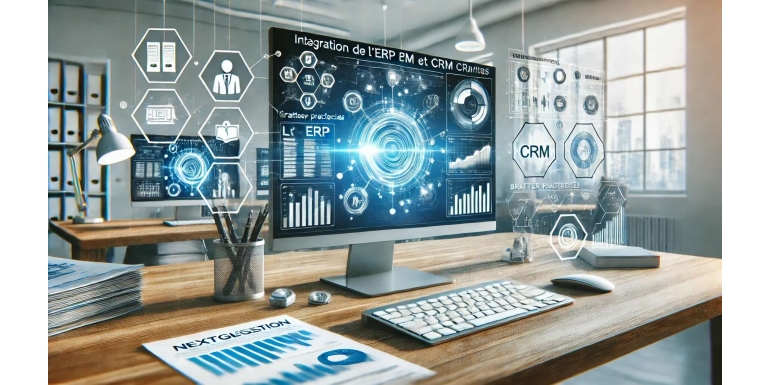
Integrating an Enterprise Resource Planning (ERP) system with a Customer Relationship Management (CRM) system is essential for businesses looking to optimize their internal processes and enhance customer satisfaction. This article will delve deeply into the best practices for achieving this integration, addressing common challenges, key steps, and long-term benefits.
1. Understanding ERP and CRM Systems
Before diving into the integration details, it is crucial to understand the respective roles of ERP and CRM.
1.1 What is an ERP?
An ERP is an integrated software solution that centralizes data and processes within a company. It manages various aspects such as accounting, inventory management, human resources, manufacturing, and more. The primary objective of an ERP is to improve operational efficiency and ensure smooth information flow within the organization.
1.2 What is a CRM?
A CRM, on the other hand, focuses primarily on managing customer interactions. It helps track sales, automate marketing campaigns, manage customer service, and analyze customer data. The CRM aims to strengthen customer relationships, retain existing customers, and acquire new ones.
1.3 Why Integrate Them?
Integrating ERP and CRM ensures that all data related to customers, sales, and operations are synchronized and accessible in real time. This facilitates a comprehensive overview of the business, improves decision-making, and enhances customer satisfaction.
2. Benefits of ERP-CRM Integration
Integrating these two systems can provide numerous advantages:
2.1 Improved Collaboration
Integration allows departments such as sales and customer service to access the same data. This fosters smooth communication and better collaboration, as all teams work from the same information.
2.2 Process Optimization
With effective integration, customer data can be utilized to enhance operational processes. For instance, sales information can help adjust inventory levels, avoiding stockouts or surpluses.
2.3 Access to Real-Time Data
One of the greatest benefits of successful integration is access to real-time data. This enables teams to make decisions based on up-to-date information, reducing the risk of errors and improving efficiency.
2.4 Enhanced Customer Experience
Having a comprehensive view of customer interactions and purchases allows businesses to provide more personalized and responsive service. This contributes to a better customer experience, which is essential for retention.
3. Steps to Successfully Integrate ERP and CRM
To successfully integrate your ERP and CRM, it is important to follow a series of key steps:
3.1 Needs Assessment
Before starting the integration process, it is essential to understand your company's specific needs. What features do you need to integrate? What are the expectations of end-users? This assessment will help you define clear objectives for the integration.
3.2 Choosing the Right Systems
It is crucial to choose ERP and CRM solutions that can easily integrate. Look for systems that offer robust APIs or built-in connectors. Also, evaluate the compatibility of these systems with your existing technological infrastructure.
3.3 Planning the Integration
Once the systems are selected, develop a detailed integration plan. This plan should include specific objectives, a timeline for implementation, and clear responsibilities for each team member. Involve all stakeholders from the outset to ensure buy-in for the project.
3.4 Defining Processes
Before proceeding with integration, clearly define the processes that will be affected by the integration of the systems. This may include how data will be exchanged between the ERP and CRM, workflows for sales and customer service, and management of returns or complaints.
4. Implementing the Integration
4.1 Data Migration
Data migration is a critical step in the integration process. Ensure that all relevant data is accurately transferred between the ERP and CRM. This often involves cleaning data to eliminate duplicates and inconsistencies.
4.2 User Training
Training users is essential to ensure that all employees understand how to use the integrated systems. Offer training sessions tailored to different skill levels to maximize adoption and utilization of the new tools.
4.3 Testing and Validation
Before deploying the integrated system, conduct thorough testing to validate all functionalities. This includes checking data flows between the ERP and CRM, as well as typical use case scenarios to ensure everything works as intended.
5. Best Practices for Effective Integration
5.1 Ongoing Communication
Maintain open communication among all stakeholders throughout the integration process. This allows for quick resolution of issues and ensures that all concerns are addressed.
5.2 Continuous Monitoring
After integration, it is essential to monitor the performance of the integrated systems. Analyze user feedback and track system usage to identify areas that need adjustments.
5.3 Feedback Loop
Regularly collect feedback from users to identify areas for improvement. This may involve adjustments to training, modifications to processes, or system updates.
5.4 System Evolution
Technology evolves rapidly. Therefore, it is important to stay informed about updates and new features of ERP and CRM systems. Integrate these improvements into your environment to ensure you are getting the most out of your tools.
6. Long-Term Benefits of ERP-CRM Integration
A successful integration of ERP and CRM offers several long-term benefits for businesses:
6.1 Improved Customer Experience
A unified view of customer data allows businesses to better respond to their needs, enhancing satisfaction and customer loyalty. Companies adopting a customer-centric approach are better positioned for success in a competitive market.
6.2 Cost Reduction
Integration can also lead to cost savings by streamlining operations and eliminating redundancies. For example, automating processes through integration can reduce the time and resources needed to perform manual tasks.
6.3 Sustainable Growth
Companies that effectively integrate their ERP and CRM systems are better equipped to adapt to market changes. They can quickly adjust their strategies based on customer data and market trends, promoting sustainable growth.
Conclusion
Integrating ERP and CRM is a strategic process essential for modern businesses seeking to enhance their operational efficiency and customer experience. By following best practices and paying attention to key steps in the integration process, companies can maximize the benefits of these systems. A successful integration not only optimizes operations but also builds strong relationships with customers, ensuring long-term success.
